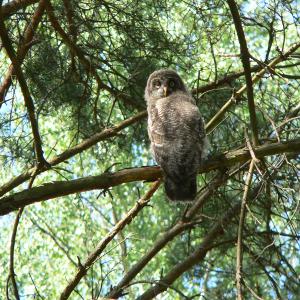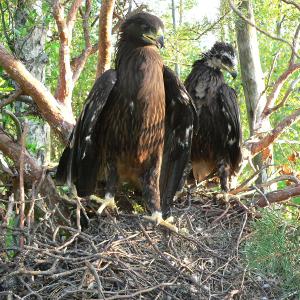Valery Dombrovski
Aims: conservation of rare and threatened wetland associated forest-dwelling species through protection of their natural habitat and raising awareness of local people.

The project is focusing primarily on the Greater Spotted Eagle (GSE), which has the status of IUCN (VU) and SPEC 1 (globally threatened) in Europe. The largest in Europe breeding population of GSE inhabit Belarus: 120-160 pairs. Key habitat of this species in Belarus is large natural fen and transitional mires alternate with waterlogged forests. Such habitat type is still present in Belarusian Polesie (Southern Belarus, river Pripyat valley). The largest natural forest-mire continuous piece has a length of about 100 km from East to West and 10-40 km from North to South. There are 3 Ramsar sites on this territory: Olmany Mires Zakaznik, Stary Zhaden and Pripyatsky National Park. According to our estimates, this area is inhabited by about 40 GSE pairs, i.e. one third of the Belarusian population. State of this breeding group determines the viability of the entire regional population of a species. Spotted eagles breed on the forest islands, usually surrounded by swamps and hardly accessible to humans. In this regard, it’s very little known about location of the nests, the exact number of pairs, threats and limiting natural/anthropogenic factors. At the same time, during the cold winter season, these forest areas are very accessible to forestry activities (cutting down). Progressing wood cutting may lead to a sharp decline in breeding success and subsequently to reduce the population size if there is any nesting trees shortage in this area. Cutting on forest islands create threats for other rare forest-dwelling species, listed in the Red Book of Belarus (2004), as Short-toed Eagle, Great Grey Owl, Black Stork, Barbastelle, Pond Bat, Natterer's and Brandt’s Bat etc. There is very scarce information about the distribution and numbers of these animals, especially bats, in the study area. Lack of information complicates the organization of effective protection of GSE and others rare species. The most critical situation is for the moment in the “Stary Zhaden” Ramsar site, which does not yet have any formal national conservation status. The same situation is as well in adjacent areas of the “Olmany Mires Zakaznik” Ramsar site. So, our research area will be about 300 km2 in the most difficult, least accessible and least studied central part of the continuous forest-mire massif.

Objectives:
~Identification of all territorial GSE’s, Short-toed Eagle’s and Black Stork’s pairs on “Stary Zhaden” Ramsar site and adjacent areas of “Olmany Mires Zakaznik” Ramsar site and “Pripyatsky National Park” Ramsar site.
~Detection of rare bat species using an ultrasonic detector.
~Search and mapping nests of rare birds and colonial settlements of rare bat species.
~Identification of GSE’s breeding success and limiting factors.
~Raised awareness of forest workers, local people and the general public about the value of this area and the presence of rare species in need of protection and careful handling (a workshop in nearby settlements, the publication in internet-resources, scientific publication).
~Preparation of documentation for the protection of forest plots where rare species breed.
~Transmission of protective documents for approval by local authorities with assistance of the local inspection of natural resources and protection of environment.
~Control of implementation of Requirements for protection of species in forestry.